South Carolina  SC Facts & Firsts
SC Facts & Firsts  SC State Symbols
SC State Symbols  SC State Wildflower
SC State Wildflower
Goldenrod in South Carolina
Goldenrod is a common sight across South Carolina, growing naturally and profusely in fields, on roadsides, and along fence lines. Its bright yellow blooms appear in the fall and attract a range of birds, insects, butterflies, and bees.
Tall Goldenrod (
Solidago altissima) became South Carolina's state wildflower in 2003, championed by garden clubs after it was determined their first choice, Queen Anne's Lace, is not native to our state.
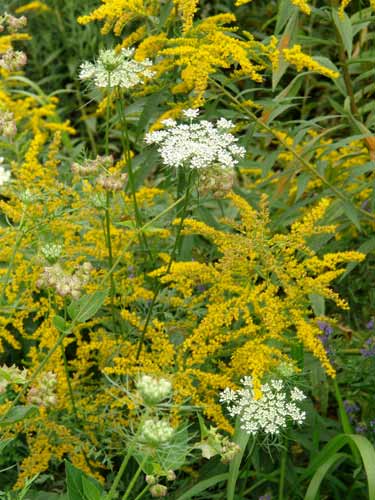
Goldenrod & Queen Anne's Lace
Traditional Uses of Goldenrod
South Carolina's Native Americans called Goldenrod "Sun Medicine" because of its bright color. They would cook the leaves and flowers together and put the mixture directly on cuts and wounds to promote faster healing. They also made a tea from the leaves to ease stomach cramps. Because of its tradition as a healing plant, the scientific name for Goldenrod became Solidago which means "to make whole" in Latin.
Native people also used Goldenrod to dye homespun cotton, wool, linen, and silk. Many weavers today still use Goldenrod to dye yarn. Depending on how the flower head is prepared, it produces either a golden yellow or dark olive-green color.
Goldenrod Video
How to Identify Goldenrod
There are many varieties of Goldenrod, which grows throughout the United States, Canada, and in Europe. South Carolina's state wildflower, Tall Goldenrod, is the largest of all the varieties. It grows upright to a height of 4 to 8 feet. Leaves grow in an alternating pattern all the way up the stem with larger leaves at the base of the stem and smaller leaves at the top. The lowest leaves usually dry up and fall off by the time the flowers appear in the fall.
The bloom is a pyramid-shaped cluster of many tiny flowers, 2 to 12 inches long. The flowers' ray-like petals are notched at the end. The weight of the flower cluster makes the stem lean so that the bloom curves downward. Once Goldenrod becomes established, it can quickly spread over a large area.
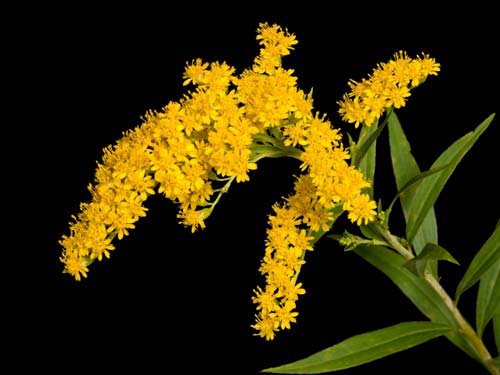
South Carolina State Wildflower – Goldenrod
Goldenrod Doesn't Cause Allergies
Goldenrod is often blamed for allergies, hay-fever, and sneezing, when in fact, these problems are caused by ragweed, which looks similar and also blooms in the fall. Goldenrod differs from ragweed in that its heavy pollen is carried by bees – not the wind. As a beekeeper in Hemingway, South Carolina explains,
Goldenrod is NOT responsible for your allergies. The pollen is heavy and sticky, designed for insect pollination, not wind. The only way to get goldenrod pollen in your nasal passages is to stick the flower up your nose!
Not only is goldenrod not harmful to humans, it is helpful to wildlife in its favored meadowland environment. Indeed, this is one of the
many attributes South Carolina's state government praised when naming Goldenrod our official wildflower. Blooms provide food for bees, wasps, butterflies, and moths. Its long stems offer a nesting place for insects to lay their eggs. Birds and small field animals find homes and protection in masses of goldenrod.
Learn more about
goldenrod versus ragweed from the US Fish and Wildlife Service.
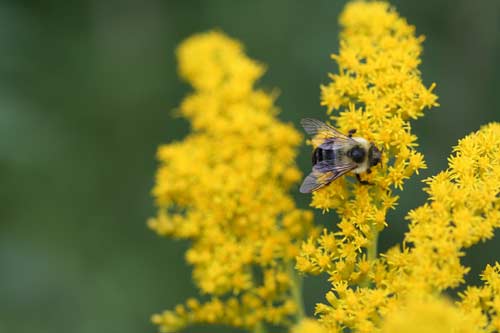
Goldenrod with Bee
Rubber from Goldenrod – Almost Famous
Goldenrod almost became an indispensable plant for American industry. In the early 1900s, Henry Ford invented the automobile and the United States' demand for rubber, to make tires, increased significantly. At that time, all rubber was imported, primarily from South America.
During WWI, the price of rubber rose from roughly 20 cents to more than two dollars a pound!
2 It quickly became clear that depending on others for such an important commodity left the United States vulnerable – and we now needed more rubber than ever for the production of cars, trucks, and tanks.
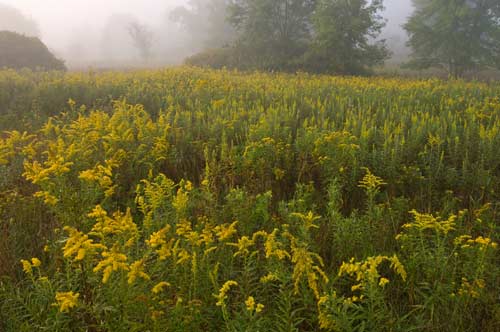
Field of Goldenrod
Henry Ford asked his good friend, Thomas Edison, to figure out how to make rubber domestically. During the last years of his life, Thomas Edison devoted himself to identifying plants that shared characteristics with the Brazilian tree that, at the time, provided most of the world's rubber.
After years of testing and crossbreeding, Edison finally determined that Goldenrod showed the greatest potential for domestic rubber production. (Honeysuckle and milkweed were also serious contenders.) It yielded a high percentage of latex, was plentiful and native to the US, and could be grown and processed within 12 to 18 months – a short enough time span to supply a war-time or emergency demand.
Sadly, goldenrod never achieved fame. Thomas Edison died before he could bring his project into production, and soon afterward the government decided to invest in new German technology that made rubber synthetically from coal and petroleum products.
So Goldenrod came back from the brink of commercial necessity and returned to its relatively nondescript existence – until it blooms each fall in a burst of yellow, reminding us that sometimes beauty is enough.
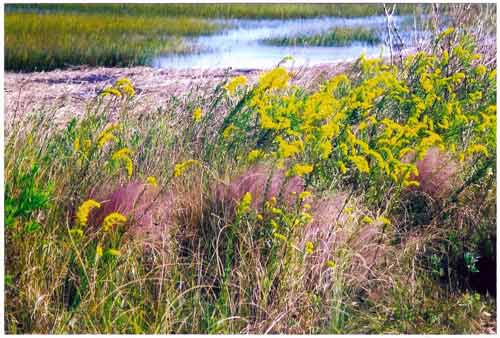
Goldenrod & Sweetgrass © Elizabeth McConnell of Hamlin Farms
More About Goldenrod




